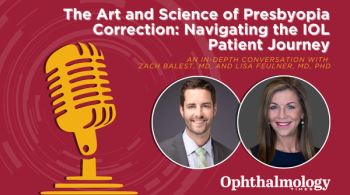
Friedenwald Lecture: The limits of human vision
David R. Williams, PhD, of the University of Rochester, Rochester, NY, received the Friedenwald Award for his studies of human optics, human cone receptors, and color vision, and for his work on the application of adaptive optics, a method to compensate for optical effects affecting ideal visualization of a target, to human retinal imaging.
David R. Williams, PhD, of the University of Rochester, Rochester, NY, received the Friedenwald Award for his studies of human optics, human cone receptors, and color vision, and for his work on the application of adaptive optics, a method to compensate for optical effects affecting ideal visualization of a target, to human retinal imaging.
In his lecture entitled "The Limits of Human Vision," Dr. Williams described adaptive optics and its uses at the annual meeting of the Association for Research in Vision and Ophthalmology.
The saga of adaptive optics began in 1975 with Dr. Williams' foray into efforts to enhance S cone sensitivity in the retina. The limitations of the experiments were blurring by the optics of the eye, ocular movements, and the lack of a method to observe cone topography directly, Dr. Williams said. He is the William G. Allyn Professor of Medical Optics and director of the University of Rochester's Center for Visual Science.
The improvements in visualization that ensued over the years were rooted in the theoretical framework provided by Jack Yellott, PhD, that guided the experiments in laser interferometry performed by Dr. Williams. Dr. Yellott developed the idea referred to as Yellott's ring - the power spectrum of the photoreceptor mosaic. The spacing between the cones shows up in the power spectrum as the radius of a ring of energy, Dr. Williams explained. Interferometry was useful to measure the cone spacing in eyes.
Dr. Williams then drew on the work of Pablo Artal, PhD, University of Murcia, Spain, and Rafael Navarro, PhD, Zaragoza, Spain, in astronomy (stellar speckle interferometry) that allows finding the space between stars.
"If the power spectra of a number of brief exposure images of the retina were averaged, the result is Yellott's ring, with its spacing of about 120 cycles per degree," he said.
Dr. Williams then added a high-magnification fundus camera to recover images of the photoreceptors. The limitations of this were aberrations (high and low order), which required correction to improve the images. He found that the Hartmann-Shack wavefront sensor for the eye was valuable and compatible with adaptive optics, which successfully corrected aberrations in astronomy.
"Without adaptive optics, the images of stars were blurry, with adaptive optics the images were clear," he stated.
Adaptive optics has two important applications in vision science: contrast sensitivity in eyes is improved more than with spherocylinder correction, which led to a number of applications in vision correction, and higher resolution retinal images can be obtained. Regarding the latter, adaptive optics can be combined with optical coherence tomography, confocal imaging, fluorescence, and scanning laser ophthalmoscopy to maximize the visualization of capillaries, the foveal neovasculature, ganglion cells, and axons, Dr. Williams said.
The Friedenwald Award is presented annually for outstanding research in the basic or clinical sciences as applied to ophthalmology.
Newsletter
Don’t miss out—get Ophthalmology Times updates on the latest clinical advancements and expert interviews, straight to your inbox.


















































.png)


